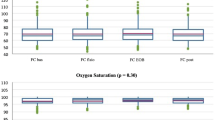Abstract
Background
Gadoxetate disodium (Eovist®, Bayer Healthcare, Wayne, NJ) is the preferred MR contrast agent for pediatric hepatobiliary imaging. A known limitation of this contrast agent is transient severe respiratory artifacts during arterial phase imaging, and some adult studies have raised caution against its use for evaluation of arterial enhancing lesions. The reported rate of transient severe breathing motion is 5–22% in adult studies. This study seeks to evaluate the frequency of transient severe respiratory motion secondary to gadoxetate disodium in a pediatric cohort.
Materials and methods
This is a retrospective, IRB-approved study with informed consent waiver. The radiology information system of a children’s hospital was searched to identify all MRI studies performed with gadoxetate disodium during January 2016–June 2018. Two readers independently evaluated all phases of a dynamic liver protocol for respiratory motion artifact on a 5-point scale (1 none, 2 mild, 3 moderate, 4 severe—still diagnostic, 5 extreme—not diagnostic). Average scores of the 2 readers for each phase were used for analyses. Transient severe respiratory motion was defined as an increase in artifact score of ≥ 1.5 from pre-contrast to arterial phase that returned to < 3 in equilibrium phase of imaging.
Results
The study cohort consisted of 140 cases (60% female), age range: 1 month–23 years (median 13 years). 102/140 scans were performed non-sedated. Mean respiratory motion score for each phase of scan for the entire cohort were pre-contrast: 2.23, arterial: 2.56, portal venous: 2.39, and equilibrium: 2.31. Transient severe respiratory motion was seen in 8 non-sedated cases and in 0 sedated cases. The rate of transient severe respiratory motion in a non-sedated pediatric cohort was estimated at 7.84% (8/102 cases).
Conclusion
The rate of transient severe respiratory motion in the non-sedated pediatric population is in the lower end of the range reported in adults. Transient severe respiratory motion is not observed in sedated patients.


Similar content being viewed by others
References
Ayyala RS, Anupindi SA, Callahan MJ (2017) Practical use and pitfalls of hepatocyte-specific contrast agents (HSCAs) for pediatric hepatic and biliary magnetic resonance imaging. Abdom Radiol (NY) 42:502-520.
Meyers AB, Towbin AJ, Serai S, et al (2011) Characterization of pediatric liver lesions with gadoxetate disodium. Pediatr Radiol 41:1183-1197.
Davenport MS, Viglianti BL, Al-Hawary MM, et al (2013) Comparison of acute transient dyspnea after intravenous administration of gadoxetate disodium and gadobenate dimeglumine: effect on arterial phase image quality. Radiology 266:452-461.
Motosugi U (2015) Gadoxetic acid-induced acute transient dyspnea: the perspective of Japanese radiologists. Magn Reson Med Sci 14:163-164.
Well L, Rausch VH, Adam G, et al (2017) Transient Severe Motion Artifact Related to Gadoxetate Disodium-Enhanced Liver MRI: Frequency and Risk Evaluation at a German Institution. Rofo 189:651-660.
Motosugi U, Bannas P, Bookwalter CA, et al (2016) An Investigation of Transient Severe Motion Related to Gadoxetic Acid-enhanced MR Imaging. Radiology 279:93-102.
Luetkens JA, Kupczyk PA, Doerner J, et al (2015) Respiratory motion artefacts in dynamic liver MRI: a comparison using gadoxetate disodium and gadobutrol. Eur Radiol 25:3207-3213.
Davenport MS, Caoili EM, Kaza RK, et al (2014) Matched within-patient cohort study of transient arterial phase respiratory motion-related artifact in MR imaging of the liver: gadoxetate disodium versus gadobenate dimeglumine. Radiology 272:123-131.
Gilligan LA, Trout AT, Anton CG, et al (2019) Respiratory motion in children and young adults undergoing liver magnetic resonance imaging with intravenous gadoxetate disodium contrast material. Pediatr Radiol 49:1171-1176.
McClellan TR, Motosugi U, Middleton MS, et al (2017) Intravenous Gadoxetate Disodium Administration Reduces Breath-holding Capacity in the Hepatic Arterial Phase: A Multi-Center Randomized Placebo-controlled Trial. Radiology 282:361-368.
Davenport MS, Bashir MR, Pietryga JA, et al (2014) Dose-toxicity relationship of gadoxetate disodium and transient severe respiratory motion artifact. AJR Am J Roentgenol 203:796-802.
Kim SY, Park SH, Wu EH, et al (2015) Transient respiratory motion artifact during arterial phase MRI with gadoxetate disodium: risk factor analyses. AJR Am J Roentgenol 204:1220-1227.
Polanec SH, Bickel H, Baltzer PAT, et al (2017) Respiratory motion artifacts during arterial phase imaging with gadoxetic acid: Can the injection protocol minimize this drawback? J Magn Reson Imaging 46:1107-1114.
Ringe KI, von Falck C, Raatschen HJ, et al (2018) Evaluation of transient respiratory motion artifact at gadoxetate disodium-enhanced MRI-Influence of different contrast agent application protocols. PLoS One 13:e0200887.
Yoon JH, Lee JM, Yu MH, et al (2018) Evaluation of Transient Motion During Gadoxetic Acid-Enhanced Multiphasic Liver Magnetic Resonance Imaging Using Free-Breathing Golden-Angle Radial Sparse Parallel Magnetic Resonance Imaging. Invest Radiol 53:52-61.
Author information
Authors and Affiliations
Corresponding author
Additional information
Publisher's Note
Springer Nature remains neutral with regard to jurisdictional claims in published maps and institutional affiliations.
Rights and permissions
About this article
Cite this article
Lanier, H., Wallace, A. & Khanna, G. Rate of gadoxetate disodium (Eovist®) induced transient respiratory motion in children and young adults. Abdom Radiol 45, 101–106 (2020). https://doi.org/10.1007/s00261-019-02296-6
Published:
Issue Date:
DOI: https://doi.org/10.1007/s00261-019-02296-6




